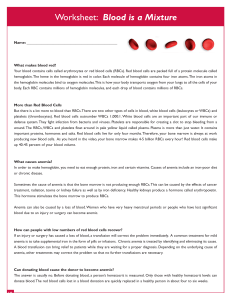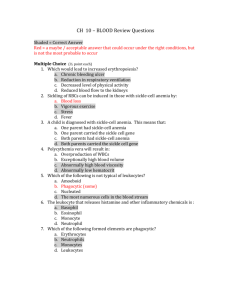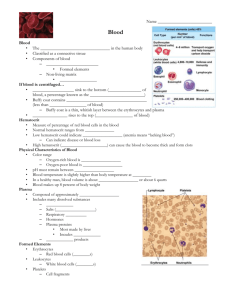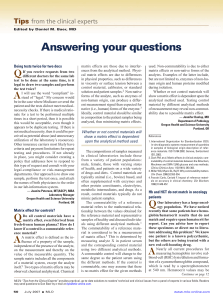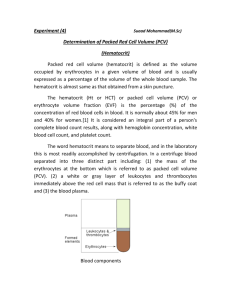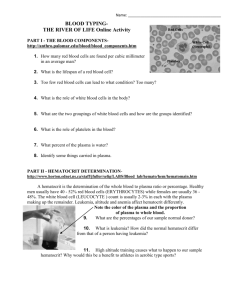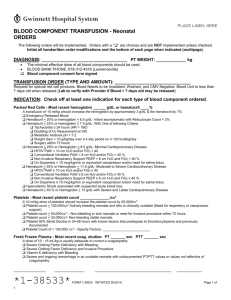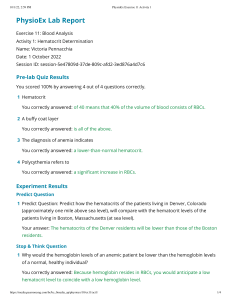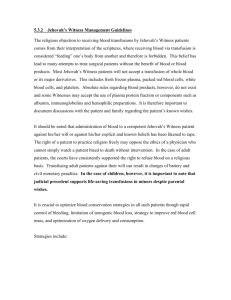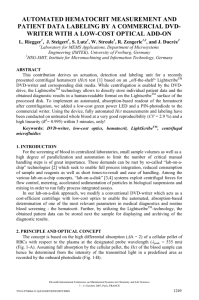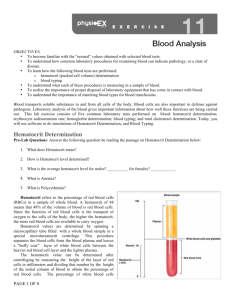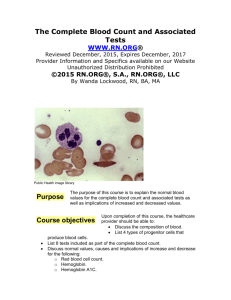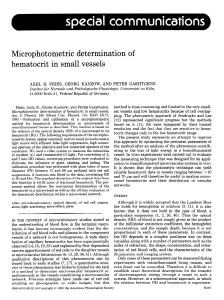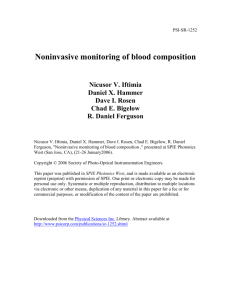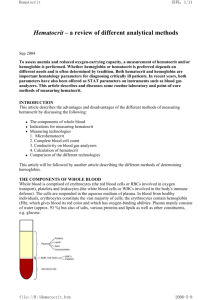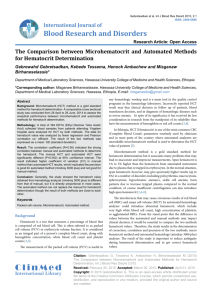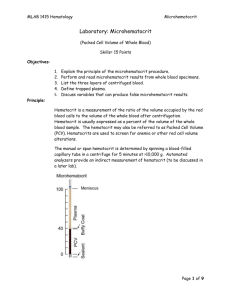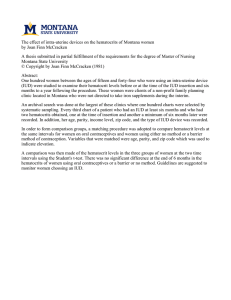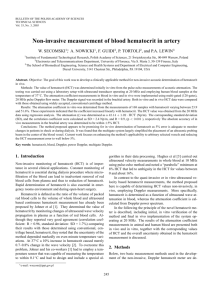Healthy Hematocrit Lab
advertisement
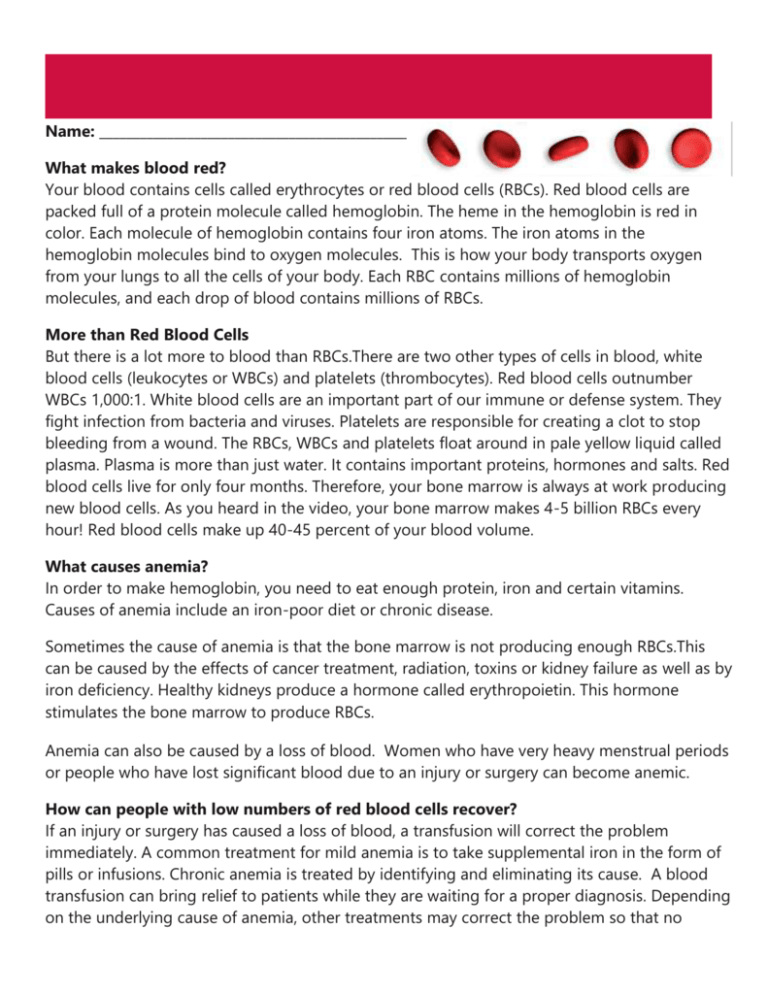
Name: ________________________________________________ What makes blood red? Your blood contains cells called erythrocytes or red blood cells (RBCs). Red blood cells are packed full of a protein molecule called hemoglobin. The heme in the hemoglobin is red in color. Each molecule of hemoglobin contains four iron atoms. The iron atoms in the hemoglobin molecules bind to oxygen molecules. This is how your body transports oxygen from your lungs to all the cells of your body. Each RBC contains millions of hemoglobin molecules, and each drop of blood contains millions of RBCs. More than Red Blood Cells But there is a lot more to blood than RBCs.There are two other types of cells in blood, white blood cells (leukocytes or WBCs) and platelets (thrombocytes). Red blood cells outnumber WBCs 1,000:1. White blood cells are an important part of our immune or defense system. They fight infection from bacteria and viruses. Platelets are responsible for creating a clot to stop bleeding from a wound. The RBCs, WBCs and platelets float around in pale yellow liquid called plasma. Plasma is more than just water. It contains important proteins, hormones and salts. Red blood cells live for only four months. Therefore, your bone marrow is always at work producing new blood cells. As you heard in the video, your bone marrow makes 4-5 billion RBCs every hour! Red blood cells make up 40-45 percent of your blood volume. What causes anemia? In order to make hemoglobin, you need to eat enough protein, iron and certain vitamins. Causes of anemia include an iron-poor diet or chronic disease. Sometimes the cause of anemia is that the bone marrow is not producing enough RBCs.This can be caused by the effects of cancer treatment, radiation, toxins or kidney failure as well as by iron deficiency. Healthy kidneys produce a hormone called erythropoietin. This hormone stimulates the bone marrow to produce RBCs. Anemia can also be caused by a loss of blood. Women who have very heavy menstrual periods or people who have lost significant blood due to an injury or surgery can become anemic. How can people with low numbers of red blood cells recover? If an injury or surgery has caused a loss of blood, a transfusion will correct the problem immediately. A common treatment for mild anemia is to take supplemental iron in the form of pills or infusions. Chronic anemia is treated by identifying and eliminating its cause. A blood transfusion can bring relief to patients while they are waiting for a proper diagnosis. Depending on the underlying cause of anemia, other treatments may correct the problem so that no further transfusions are necessary. Can donating blood cause the donor to become anemic? The answer is usually no. Before donating blood, a person’s hematocrit is measured. Only those with healthy hematocrit levels can donate blood. The red blood cells lost in a blood donation are quickly replaced in a healthy person in about four to six weeks. Questions Name: ________________________________________________ 1. Why is it important to get enough iron in your diet? 2. Without oxygen, our cells cannot work. Which of the following might be an explanation why someone feels weak? a. They do not have enough hemoglobin b. They do not have enough red blood cells c. Either a or b would cause someone to feel tired and weak 3. What type of blood cell far out numbers the others in the blood? 4. If you fell down and scraped your knee, describe what each type of blood cell would be doing at the site of injury. 5. What are two ways someone can become anemic? 6. What are two treatments for anemia? 7. Which treatment would work best to help someone who has been in a car accident and lost a lot of blood? 8. What would you tell someone who’s not sure if they can give blood because they think they might be anemic? Lab: Healthy Hematocrit Name: ________________________________________________ Purpose: To measure the percent of red blood cells volume of simulated blood samples to determine the hematocrit. Once you have measured the hematocrit of each “patient” you can determine if the person has a low hematocrit, normal hematocrit or is polycythemic (too many red blood cells). Materials 4 Test tubes Simulated blood sample Metric ruler Marking pen Procedure 1. Obtain a sample of simulated blood. 2. Mix it up with a stirring rod and fill a test tube 2/3 full. 3. Let the blood cells settle for 10 minutes. 4. Using the centimeter side of a ruler, measure the distance from the bottom of the test tube to the top of the blood sample. Record this measurement in your data table. 5. Now measure the height of the blood cell layer from the bottom of the test tube. Record this measurement in your data table. 6. To determine the hematocrit, (which is simply the percentage of the blood that is made up of cells) divide the height of the blood cells by the total height of the blood and multiply that by 100. (Height of blood cells in cm/ total height of blood x 100 = hematocrit) Compare your results to the chart below to diagnose your patient: 38-50 percent = NORMAL Less than 38 percent = POSSIBLE ANEMIA (low hematocrit level for the purpose of blood donation) More than 50 percent = POSSIBLE POLYCYTHEMIA (excess blood cells) Total Blood Height (cm) Blood Cell Height (cm) Hematocrit Normal/High/Low Patient A Patient B Patient C Patient D Lab Questions: 1. What was the condition of the blood of each patient you tested? 2. Some athletes practice something called “doping”. This is where they inject themselves with erythropoietin to increase their red blood cell level to improve their ability to get oxygen to their muscle cells. This causes their hematocrit to be above normal. Many people consider this practice unethical and proof of doping with erythropoietin is cause for disqualification in many sports. a. Do you think blood doping should be allowed in athletics? Explain. b. A serious condition occurs if the hematocrit exceeds 70 percent. What adverse affect do you think too many red blood cells would have on the circulatory system?
